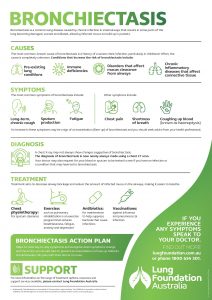This colourful infographic from the Lung Foundation Australia is designed to help you understand bronchiectasis – a chronic lung condition that can seriously impact your breathing and overall quality of life. Its main purpose is to educate Australian consumers about what bronchiectasis is, how it affects the lungs, and what steps you can take to manage and improve your lung health.
Bronchiectasis happens when the airways in your lungs become permanently widened. This abnormal widening makes it difficult for your body to clear out mucus, leading to build-ups that can cause repeated chest infections. The infographic explains that common signs of bronchiectasis include a long-lasting cough, production of a lot of mucus (or sputum), breathlessness, and frequent lung infections. By highlighting these symptoms, the resource aims to encourage you to get an early diagnosis – an important step in managing the condition effectively.
The resource also sheds light on some of the causes behind bronchiectasis. It points out that repeated lung infections and other underlying conditions can damage the airways over time, resulting in bronchiectasis. If you notice a persistent cough or experience changes in your breathing, the infographic advises you to consult your doctor. Diagnostic tools like CT scans or chest x-rays are essential to confirm the condition, ensuring you receive the right treatment as early as possible.
When it comes to management, the infographic offers practical advice on how to live well with bronchiectasis. It recommends a range of treatments, including the regular use of antibiotics to control infections, and practising airway clearance techniques – exercises that help clear mucus from your lungs. Additionally, it encourages healthy lifestyle choices such as quitting smoking, engaging in regular physical activity, and eating a balanced diet, all of which support better lung function.
For everyday application, the infographic provides clear tips that can be easily incorporated into your routine. Whether you’re newly diagnosed or have been living with bronchiectasis for some time, following a consistent treatment plan and keeping regular appointments with your healthcare provider are key steps to managing the condition effectively.
Take a proactive approach to your lung health – if you’re experiencing any symptoms or have concerns about your breathing, have a chat with your doctor today. Your lungs will thank you!
Was this page helpful?
Good job! Please give your positive feedback
How could we improve this post? Please Help us.
